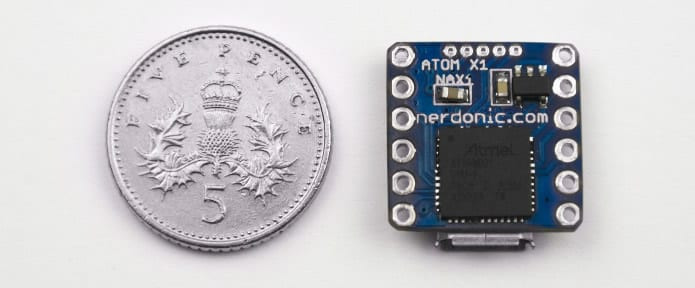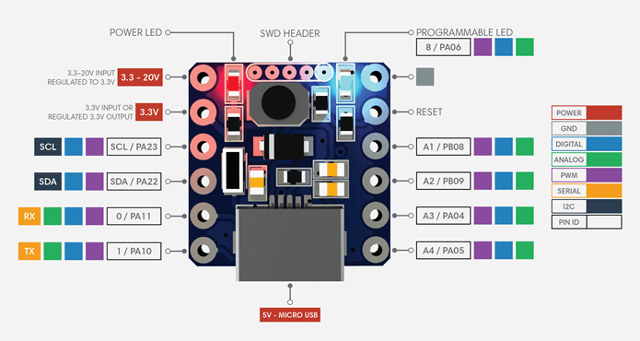Back in June, we reported about μduino board, which at 12×12 mm may well be the world’s smallest Arduino compatible board. It is based on Microchip Atmel ATMEGA32U4 8-bit AVR microcontroller.
But there’s now a new board in town which claims to be the world’s smallest 32-bit Arduino board: Exen Mini measuring 14.9×14.9 mm. While I’m patiently waiting for an Intel’s DMCA request, or more likely an email requesting an update once the name has changed, like I had to do for Atomwear Vigekwear, let’s have a look at what the board has to offer.
Exen Mini specifications:
- MCU – Microchip Atmel SAMD21 Cortex M0+ MCU @ 48 MHz with 256KB flash, 32KB SRAM
- I/Os via 2x 5-pin 2.54mm pitch headers
- Up to 8x digital I/O
- Up to 8x PWM
- Up to 6x analog (ADC)
- 1x UART
- 1x I2C
- 1x reset
- Limits – 3.7V, 7mA
- USB – 1x micro USB port
- Programming – via micro USB port or SWD header
- Misc – Power LED, user LED, button
- Power Supply
- 3.3-20V (regulated to 3.3v) via power Pin 1
- 3.3V via power pin 2
- 5V (regulated to 3.3v) via Micro USB port
- Current Draw Atom X1 = ~10mA
- Dimensions – 14.9 x 14.9 x 4.4mm
- Weight – 0.95 grams
The board is breadboard compatible, pre-flashed with Arduino Zero bootloader, and can be programmed in the Arduino IDE just like the original board.
Nerdonic, the company behind the project, is also working on both a slightly larger version of the board with 20 I/O pins, and and even smaller version using 1.27mm pitch headers. An ecosystem with modular shields/hats is also planned, but no details were provided.
The project has been launched on Indiegogo with a flexible goal. Early bird rewards start at 10 GBP (~$13.2 US) for the board with shipping adding 2 GBP to the UK, and 7 GBP to the rest of the world. In you’d like more than one, you can save on shipping by getting 5 or 10 boards packs. Delivery is scheduled for December 2017.
Via Time4EE

Jean-Luc started CNX Software in 2010 as a part-time endeavor, before quitting his job as a software engineering manager, and starting to write daily news, and reviews full time later in 2011.
Support CNX Software! Donate via cryptocurrencies, become a Patron on Patreon, or purchase goods on Amazon or Aliexpress. We also use affiliate links in articles to earn commissions if you make a purchase after clicking on those links.







Wait, it lacks SPI pins….I personally don’t know what is the point of making it too small while sacrificing basic peripheral connectivity.
@Bumsik Kim
I think you could get the full SERCOM0 by using PA04 (PAD[0]) PA05 (PAD[1]) and PA10 (PAD[2]) PA11 (PAD[3]) which would get you a full SPI …
or you could run 4 uarts (and do nothing else.)
@Bumsik Kim
Don’t forget the native FS USB, which along with the small size more than makes up for missing SPI imho. Think of the tiny HID- or MIDI-class devices made possible, especially of the wearable variety.
Also consider the concept of “smart” peripherals, such as motor control of a drone, with a gyro and accelerometer on the I2C bus, movement/attitude commands and reports over serial (or FS USB), and the remaining four (or six) PWMs driving motors or servos. Or a galvanometer driver for mirrors for laser projection of images from RAM or ROM. Or a small, battery-powered six-channel data logger to I2C flash with USB mass-storage-class downloading.
The ST Sensortile is only13.5 by 13.5mm, slightly smaller.
@Brian
True, but it’s more like a module than a development board IMHO.
As expected Atom X1 board had to be renamed, and it’s now called Exen Mini.
The board is now sold on eBay for 10 GBP: https://www.ebay.co.uk/itm/183290650478
Exen Mini group buy for $11.30 @ https://groupgets.com/campaigns/443-exen-mini